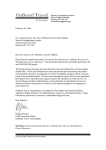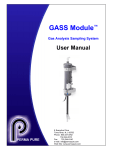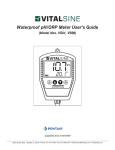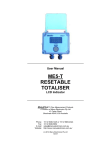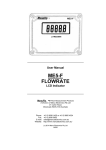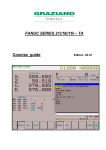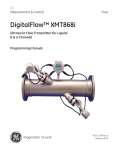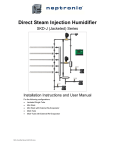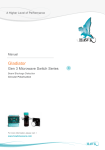Download key features - Pentair Environmental Systems
Transcript
M500 ELECTROMAGNETIC FLOWMETER OPERATION AND CONFIGURATION MANUAL IMPORTANT SAFETY INSTRUCTIONS READ AND FOLLOW ALL INSTRUCTIONS SAVE THESE INSTRUCTIONS 2 CUSTOMER SERVICE/TECHNICAL SUPPORT/REFERENCE DOCUMENTS If you have questions about ordering Pentair water flow or water monitoring replacement parts, please use the following contact information: Technical Support Reference Documents For technical support please quote the following details which are located on the instrument enclosure. Associated documents available for the M500 Electromagnetic Flowmeter include: Serial Number, example 123456 Part Number, example IR2020 Name and Model: Emflux 500 Series Flowmeter Power supply, voltage and frequency, if known. M500 Electromagnetic Flowmeter Operation and Configuration Manual M500 Electromagnetic Flowmeter Remote Communications Guide M500 Electromagnetic Electromagnetic Flowmeter File Download Protocol Guide. © 2014 Pentair Aquatic Eco-Systems, Inc. All rights reserved. This document is subject to change without notice. 2395 Apopka Blvd., Apopka, FL 32703, USA Phone: 407.886.3939 Web: PentairAES.com 1-21 Monash Dr., Dandenong South, VIC 3175, Australia Phone: 011 61 1 300 137 344 All Pentair trademarks and logos are owned by Pentair or one of its global affiliates. Pentair Aquatic Eco-Systems™, Pentair Environmental Systems™ and Emluc™ are trademarks of Pentair Aquatic Eco-System, Inc. and/or its affiliated companies in the United States and/ or other countries. Unless expressly noted, names and brands of third parties that may be used in this document are not used to indicate an affiliation or endorsement between the owners of these names and brands and Pentair Aquatic Eco-Systems, Inc. Those names and brands may be the trademarks or registered trademarks of those third parties. Because we are continuously improving our products and services, Pentair reserves the right to change specifications without prior notice. Pentair is an equal opportunity employer. PAES700-7.A 12/10/14 M500 Operating & Installation Manual 3 TABLE OF CONTENTS Customer Service/Technical Support..................2 Key Features..........................................................27 Reference Documents...........................................2 Operation.........................................................29 Table Of Contents...................................................3 Power up Display.............................................29 Safety and Usage Precautions..............................4 Flow and Totaliser Channels Displays............31 Introduction.............................................................5 Passcode Entry...............................................32 Principle of Operation.......................................5 Settings and Diagnostic Information Displays........................................34 Model Numbering and Optional Accessories........................................6 Configuration...................................................37 Electrical Characteristics..................................8 Configuration Menus.......................................37 Flow Measurement Characteristics.................9 Configuration Sub-menus...............................37 Display and Keypad Characteristics..............10 Parameter Types..............................................38 Digital IO Functional Characteristics.............10 Changing Numeric Parameters......................39 Analog Output Functional Characteristics..... 11 Changing Time Parameters............................42 Ancillary Hardware Functional Characteristics.............................. 11 Changing Date Parameters.............................44 Diagnostic Functions Characteristics............ 12 On-board Data Logger Functional Characteristics................................................. 12 Selection and Configuration of Digital Output Parameters..............................46 Detailed Menu Parameter List........................51 Maintenance..........................................................56 Communications Functional Characteristics................................................. 12 General.............................................................56 Physical and Environmental Characteristics................................................. 13 Flow Transmitter..............................................56 Flow Detector...................................................56 Dimensions...................................................... 14 Troubleshooting Guide.........................................57 Quality Assurance and Tracabilit.................... 14 Display is Blank...............................................57 General Description............................................. 17 Display Is Erratic and Does Not Read Zero........................................57 Nameplate........................................................ 17 Calibration Certificate.....................................18 No Response to Flow......................................57 Electronics Configuration Fingerprint............19 Flow Detector Installation...................................20 Pipe Location and Arrangement.....................20 Electrical Installation of Flow Detector..........23 Signal Cable Connection..........................23 Pipe Not Full (PNF) Cable Connection.....23 Coil Drive Cable Connection....................23 Earthing.....................................................23 Flow Transmitter Installation...........................25 Electrical Installation – M500...................25 Flow Signal................................................26 Coil Connection.........................................26 Pipe Not Full Cable...................................26 M500 Operating & Installation Manual 4 SAFETY AND USAGE PRECAUTIONS • Read and understand all installation instructions contained in this Manual. • If the equipment is used in a manner not specified by Pentair, the protection provided by the equipment may be impaired. • Only suitably qualified personnel may remove any covers on this product. • Lethal voltages may be present on conductors, wiring and on surfaces that are exposed when a cover is removed from this product. • Be aware that the coil driver connections and associated wiring may generate voltages capable of producing an electric shock. • Observe the required environmental conditions and recommended operating conditions for this product. • If this product does not operate normally then refer to the troubleshooting information contained in this Manual. • There are no operator serviceable parts inside this product. Please refer servicing and repair to qualified service personnel. • Ensure that the flow transmitter enclosure is sealed and that the unit is stored in a dry environment if it is not to be put into service immediately. The M500 is provided with gland plugs which enable sealing when cable is not fitted, also acting as an important safety measure. Installers must fit provided gland plugs to any unsealed cable glands. A potential electrocution risk may exist if any loose object penetrates an open gland in the base. • The flow detector may have an insulating lining that extends to the end of the tube within the flow detector or over the flange faces. Do not drag or roll the unit on its end as this may damage the liner. • The flow detector must be installed in a position such that it remains full of liquid at all times during normal operation. M500 Operating & Installation Manual • Cabling between the flow detector and the flow transmitter should be protected from external damage and must be routed away from cables and machines that can generate significant electromagnetic interference such as variable frequency drives and electrically operated machines. The recommended technique is to install the cable between the flow transmitter and flow detector within a metallic conduit, bonded to earth and with suitable physical protection where the cable enters and exits the conduit. • Prior to commencing installation, ensure that the flow detector and flow transmitter are stamped with serial numbers that match those listed in the calibration report. Every M500 Flowmeter is provided with a calibration report and copies may be obtained from Pentair Environmental Systems if required. • Where fitted, eye bolts should be used to lift the flow detector. If eye bolts are not fitted, slings and spreaders should be used. Be aware of the considerable weight of flowmeter components and always use safe lifting practices to avoid personal injury. • 2060 flow detectors have an insulating liner that extends over the flange faces. This liner does not act as a gasket and pipe gaskets must be fitted during installation. 5 INTRODUCTION Please note that this symbol is used to highlight aspects of particular importance with respect to the operation and safety of the instrument. Please ensure that you are conversant with the operation, installation and precautions contained within this manual before installation or operation of the flow meter. Principle of Operation The operating principal of the electromagnetic flow detector is based on Faraday's law of magnetic induction that states that the voltage induced across any conductor as it moves at right angles through a magnetic field is proportional to the velocity of that conductor as depicted below: The signal voltage, Es, between the two electrodes is proportional to the magnetic flux density (B), the distance between the electrodes (D) and the average flow velocity (V) of the fluid. Es = B x D x V x K (Equation 1) Where: Es = induced electrode voltage B = magnetic field strength D = flow detector diameter V = liquid flow velocity K = Constant value The flow transmitter is capable of producing an accurate and stable current source so that the magnetic flux density (B) is constant. The electrode spacing (D) is equal to the flow detector diameter and is constant due to the construction of the flow detector. Hence the induced electrode voltage, Es is proportional to the flow velocity, V of the fluid. Equation 1 can also be expressed to show that the signal voltage Es is proportional to the volumetric flow rate, Qv: Qv = π x D2 x V4 (Equation 2) Es = B x D x K x (Qv / (¶ x D2))0.25 (Equation 3) The application of Faraday’s law for any magnetic flowmeter has a number of implications: Every Pentair flow detector contains windings (electromagnetic coils) that produce a magnetic field when a pulsed DC current is applied from circuitry within the flow transmitter. The movement of the fluid (i.e. the conductor) through the pipe and through the magnetic field produces an electric voltage potential. The voltage is present within the fluid and is shown as electric field lines in the above figure. This resulting voltage, Es, is measured by the flow transmitter at the measuring electrodes which are directly exposed to, and in contact with the fluid. • The resulting voltage Es is not dependent on the conductivity, but the material flowing through the pipe must have a certain level of conductivity for the principle to work. For water flow applications there is a minimum level of electrical conductivity (EC) below which the accuracy of the measurement will suffer. Pentair flow transmitters routinely check water conductivity and can produce an alarm if the conductivity is too low. • The material in the pipe must cover the electrodes and in most practical applications the pipe must be full at all times for accuracy of measurement. Pentair flowmeters include a pipe not full detector, which is an additional connection from the flow detector to the flow transmitter. • The Pentair M500 Flowmeter includes electronic and digital signal processing functions to provide excellent noise reduction and signal to noise improvement. M500 Operating & Installation Manual 6 INTRODUCTION Model Numbering and Optional Accessories M500 Specification Code Details I500- Flow transmitter with DC input (12 to 24V). FW 5 Firmware release version code. Options Serial X M R USB communications only (standard). Modem port (low power RS232/RS485/RS422) with MODBUS. Isolated RS485/RS422 port with MODBUS. Analogue Outputs X M No analog outputs (standard). 2 x 4-20mA selectable sourcing or sinking & isolation. Digital IO X 4D 2 x multifunction outputs (standard). 1 x input, 4 x multifunction outputs. Options Specification Code Details 625054 Dual Analog Output Option Card 625055 Isolated RS485/422 Card with Modbus 625056 Modem Interface Card (RS232/RS485/RS422) with Modbus 625057 Digital Expansion Card Accessories Specification Code Details MAGMATE-USB MagMate Software on USB Memory Stick CABLE-USB-AB-1 USB connecting cable – 1 meter M500 Operating & Installation Manual 7 INTRODUCTION Features • Programmable alarms and status indication. • Flow velocity, volume and mass flow measurement with computation and display of forward, reverse and net flow. • Capacitive touch sensitive buttons for long life mechanical-free operation of keypad. • Programmable peak and off-peak flow totalisation. • Graphic LCD display with LED backlighting for ease of use and simultaneous display of multiple flow variables. • Programmable year to date (YTD) flow totalisation. • USB communications interface for ease of connection in the field to portable computers with Pentair MagMate software. • Logged data download via on-board USB port. • Automatic self-zero and common mode signal checking. • Internal digital filtering of input signals with programmable 50/60 Hz filter response. • On board data logging with log data storage to micro-SD card. • Password protection for setup parameters for changes made via communications interface and from front panel interface. • *Up to four multi-function isolated digital outputs with selectable operation: alarm/status, pulse output or frequency output*. • *Up to two analogue outputs with programmable selection of output variable and selectable loop or local powered operation. • *Isolated multi-function digital input provides additional control capabilities. • Simulation mode for quick diagnosis and training • Automatic calibration and advanced self diagnostic functions. • Integral self test. • Removable storage media (micro SD card) for portability of setup configuration, logged data and diagnostics. • *MODBUS communications interface with selection of communications parameters including RTU or ASCII mode, 2 wire or 4 wire interface. • Low power operation (I series) with programmable on and off times for power management. • *Modem compatible serial interface for remote sites. • Programmable high accuracy current source with fast settling time. • Wake command function allows polling by third-party systems via Modbus interface. • Worldwide EMC Compliance. *Note An option card may be required to provide feature. M500 Operating & Installation Manual 8 INTRODUCTION Electrical Characteristics Flow Transmitter Digital Outputs: Type Switching Capacity Rated Contact Voltage Rated Contact Current Opto-isolated open collector NPN 3 Watts DC 30 Volts DC 100 milliamps DC Digital Input: Operating voltage range 0 to 30 Volts DC Analog Outputs: Maximum loop resistance Nominal circuit voltage Over range indication 500 Ω 24 Volts DC 22 milliamps DC Signal Measurement: Resolution Linearity Sampling Rate Isolation Input Range 23 bits ±0.001 % 2000 samples per second Approximately 30 Volts DC. ±13 millivolts DC Fusing Internal Fuse Type: T2A. Ensure power is disconnected before disconnecting or reconnecting the fuse. Coil Drive Circuit: Resolution Current Output Range Voltage Range Switching Frequency Range Settling Time (typical)1 Coil resistance range 16 bits 100 to 200 milliamps DC 0 to ±36 Volts DC 0.0033 to 16 pulses per second. Less than 5 milliseconds 25 to 110 Ω Notes: 1. A ctual value depends on process conditions. 2. D ependent on daylight conditions, coil current and measurement duty cycle. Flow Detector Coil Resistance EM Series M500 Operating & Installation Manual Typical value in ohms: 40 ±25 Notice relating to Coil Current: Maximum reliable coil current for the 500 series transmitter is 200mA 9 INTRODUCTION Flow Measurement Characteristics Flow velocity range: 0.01 to 10.00 metres per second Turndown ratio: 1000:1 Linearity: <0.005% Repeatability: <0.05% Accuracy: Better than ±0.5% of flow or ±1mm per second whichever is greater. Temperature stability: <0.05% over temperature range Noise filtering: Analog bandpass rejection filter Digital slope compensation filter Digital noise reduction filter (50/60 Hz). Full scale flow rate: Programmable Low flow cut-off: Programmable from 0 to 10% of full scale flow rate. Totalisers are not updated when flow is below the low cut-off value Measurement on-time: Programmable from 3 to 3600 seconds Measurement off-time: Programmable from 0 to 3600 seconds Low flow off-time: Programmable from 0 to 30000 seconds Flow channels: Flow velocity Volumetric flow rate Mass flow Totalised channels: Total volumetric flow Total volumetric flow in forward flow direction Total volumetric flow in reverse flow direction Total volumetric flow during peak hours Total volumetric flow in forward direction during peak hours Total volumetric flow in forward direction during off-peak hours Year to date total volume Year to date total volume in forward direction Year to date total volume in reverse direction Flow and Totaliser Volume units: Programmable selection: • Litres, kilolitres, or mega litres, • Cubic feet, Acre feet. • Imperial Gallons, Imperial mega-gallons, • US Gallons, US mega-gallons, • User programmable unit conversion factor. Flow time units: Programmable selection: • Seconds, Minutes, Hours, Days, • User programmable unit conversion factor. Flow simulation mode 1: When enabled the user can enter a value for the flow rate, all outputs and rate calculations are set according to the simulation value. The coil driver outputs continue to operate. The totalisers do not update. Flow simulation mode 2: Performs same function as mode 1 but with the coil drive output current fixed at a constant DC value. M500 Operating & Installation Manual 10 INTRODUCTION Display and Keypad Characteristics Graphic LCD Type: 128 x 64 pixel monochrome graphic type with LED backlighting. Backlight operation: Can be enabled or disabled, includes auto-off mode when enabled and after 30 seconds of keypad inactivity. Keypad: Four button capacitive touch with adjacent key suppression, self calibrating, with wake function and press or hold discrimination. Data update rate: Approximately 1 Hertz. Display characters: Customised character sets (three styles) plus Icons, international character and language capability. Password access: Single level access to detailed data displays and configuration settings. No password required to view flow rates and totals. Configuration menu: Two-level hierarchy: menu and submenu with numerical index to each menu item for ease of cross referencing. Meter Identification Programmable meter code Digital IO Functional Characteristics Digital Output Mode: Digital outputs can be individually programmed for : • Alarm output (activated by an alarm condition – see below) • Frequency output (proportional to flow rate channel value) • Pulse output (one pulse generated for a specified volume) Alarm Output Mode: Programmable alarm cause: • Low battery voltage • Pipe not full • System fault • Low flow • High flow • Forward flow detected • Reverse flow detected • Analog output 1 over-range • Analog output 2 over-range Frequency Output Mode: • Resolution • Range • Duty Cycle 1 Hertz 4 to 1000 Hz 50 % 73Pulse Output Mode: • Volume per pulse • Maximum Rate • Pulse Width Programmable: 1 to 1000 flow units. 20 Hertz Programmable 20 to 200 ms Digital IO Scan Rate Approximately 1 Hertz M500 Operating & Installation Manual 11 INTRODUCTION Analog Output Functional Characteristics Analog output mode: Analog outputs can be individually configured for : • Forward or reverse acting • Sinking or current sourcing Output scaling: 0 to 100% of programmed full-scale flow rate Output update rate: Approximately 1 Hertz Ancillary Hardware Functional Characteristics Power On Self Test The following tests are performed during power on: • ADC – Analog to Digital Converter test • ESN – Electronic Serial Number test • CRC – CRC Data validation of Configuration data • DAT – SD Card format and file system verification • RTC – Real Time Clock test • PSU – Power supply voltages test • CIV – Coil Current and Voltage test Internal temperature monitor. An internal temperature monitor is used to record the temperature within the flow transmitter and the temperature is logged to the SD card. Internal clock/calendar High accuracy real time clock circuit with long life battery backup • 1 second resolution • Integral calendar functions • Alarm function, used to schedule internal data logger. Non-volatile memory Semiconductor non-volatile memory circuits for storage of: • Factory calibration data • Meter calibration and configuration data • Totaliser values • Diagnostic information. • CRC16 checksum validation for all non-volatile data Electronic Serial Number A unique electronic serial number is stored in silicon for each flow transmitter. Onboard Solar Regulator Battery voltage, battery current and solar voltage are routinely monitored. Battery charging is enabled by connection of the solar panel through a series diode to the battery when solar voltage exceeds battery voltage by 4.0 volts. The solar panel is disconnected when battery voltage exceeds 14.8 volts to prevent overcharging. M500 Operating & Installation Manual 12 INTRODUCTION Diagnostic Functions Characteristics Scan Interval Programmable: to a multiple (1 to 20) of the data logging interval Diagnostic Checking Diagnostic checks are routinely performed to ensure correct operation of the flow meter. These checks may be used to generate alarms and may also prevent the totals from being updated with erroneous values. • Coil voltage check • Coil current check • Electrode check • Pipe Not Full detection • Signal voltage check Additional System checks • Configuration and calibration data integrity • A /D Converter operation and self calibration • Real Time Clock operation On-board Data Logger Functional Characteristics Logging interval: Programmable from 1 minute to 12 hours Log data storage: Removable micro-SD card, formatted for FAT (FAT16) allowing files to be read and copied when the card is inserted into a personal computer. File system: PC Compatible directory structure with individual files for: • Flow data records (CSV) • Diagnostic results records (CSV) • System event records (CSV) • Alarms records (CSV) • Configuration data (binary format) *Comma Separated Volume file, suitable for import into spreadsheet applications. Communications Functional Characteristics USB Protocol Proprietary packet-based command and file transfer protocol. Serial Port Command Protocol Selectable: MODBUS RTU or MODBUS ASCII Serial Port File Transfer Protocol Proprietary packet-based command and file transfer protocol. Serial Port Baud Rate: Selectable: 9600, 19200 or 38400 Serial Port Line Settings: No parity, 8 data bits, 1 stop bit (N,8,1). Supported MODBUS function codes: 03 – Read Holding Registers 06 – Write Single Register 16 – Write Multiple Registers M500 Operating & Installation Manual 13 INTRODUCTION Physical and Environmental Characteristics M500 Flow Transmitter Enclosure Construction: Pressure Die Cast Aluminium Cable Entries 1xM25 Gland, 1xM20 Gland, 3xM16 Gland. Weight: Overall Dimensions: 273H x 115D x 182W Ambient temperature: -10 to 55° C Flow Detector Housing Construction: IR2060 - Mild steel with 2 part epoxy coating IRIR2030 - 304 stainless steel IR2020 - ABS Ambient temperature: -10 to 55° C Protection Class IP68 to 5 metres (IR2020 IP68 to 1.5 metres) Electrodes 316 Stainless Steel (Standard) Lining: IR2060 - insulation rubber (Standard) IR2030 - insulation rubber IR2020 - ABS Submergibility: IR2060 – 10 metres IR2020 – 1.5 metres Connecting Cables Signal Cable 4x16/0.2 BRAIDED SCREEN Pipe not Full cable 4x16/0.2 BRAIDED SCREEN Coil Driver Cable 1.5mm TWIN & EARTH ORANGE CIRCULAR Power Cable 1.0mm Rubberised M500 Operating & Installation Manual 14 INTRODUCTION M500 Flow Transmitter Casing Dimensions Quality Assurance & Traceability Quality System Assurance: This product is manufactured under a quality system certified as complying with ISO 9001:2008. Statement of Traceability: Master Calibration equipment is certified in accordance with Regulation 13 of the National Measurement Regulations 1999, Certificate No 34384854801260. NATA Certification The Pentair flow meter manufacturing facility has NATA certification to an accuracy of +/-0.18% for calibration and testing of flow meters in the size range 50mm to 200mm diameter. NATA certification provides independent confirmation of the accuracy of the manufacturing plant and test flow facilities and is a further step closer to full Pattern Approval for the Australian made Pentair Magnetic Flow Meters. Note: Drawings not to scale. M500 Operating & Installation Manual 15 INTRODUCTION 2060 Flow Detector Dimensions M500 Operating & Installation Manual 16 INTRODUCTION 2020 Flow Detector Dimensions M500 Operating & Installation Manual 17 GENERAL DESCRIPTION A 500 Series Electromagnetic flowmeter consists of an electronic flow transmitter, an electromagnetic flow detector, and interconnecting cables. Mains-powered flowmeters are pre-wired with AC power cable with internal AC-DC conversion. The electronic circuit board and optional equipment cards are mounted inside a powder coated die-cast aluminium casing. In the case of the 2020, a duplicate label is inserted inside the junction box. This will allow the details of the unit to be traced and/or retrieved in the event that the label is rendered illegible after prolonged burial. 2060 flow detectors have identifying numbers stamped on one flange that allows full factory information to be retrieved. Simply call the factory or your nearest Pentair representative and provide them with this number. Explanation of label information Type: Abbreviated model number for the flow detector. May be either IR2020, EM2020, IR2060 or EM2060. No.: Unique serial number for the flow detector. Size: Nominal pipeline size for the flowmeter. The flow transmitter mounts on a 50mm diameter pole normally placed within 10 metres of the flow detector. Longer distances are possible but must be specified at time of ordering. The limitation is a maximum cable length of 100 metres. 2020 Flow Detector 2060 Flow Detector Nameplate A polyester label is fixed to the outside case of each meter. This contains information such as type number, size and calibration information. Tubefac: A calibration factor established by flow testing the flowmeter system in the flow laboratory at the factory in Australia. This factor is entered into configuration parameter of the 500 series flow transmitter connected to the flow detector for the system to be accurate. For your convenience, on a new installation, this parameter has normally been entered into the flow transmitter prior to the system leaving the factory. It is recommended that the calibration report form for the flow detector and flow transmitter be checked to ascertain the mating serial numbers prior to installation. Zero: A calibration factor established by flow testing the flowmeter system at the factory in Australia. This factor is entered into configuration parameter of the 500 series flow transmitter connected to the flow detector for the system to be accurate. For your convenience, on a new installation, this parameter has normally been entered into the flow transmitter prior to the system leaving the factory. It is recommended that the calibration report form (see sample below) for the flow detector and flow transmitter be checked to ascertain the mating serial numbers prior to installation. M500 Operating & Installation Manual 18 GENERAL DESCRIPTION Calibration Certificate A wet Test Calibration certificate is issued with every flow meter. It records serial numbers, configuration settings and calibration parameters and confirms operational performance accuracy within specifications. M500 Operating & Installation Manual 19 GENERAL DESCRIPTION Electronic Configuration “Fingerprint” A full electronic record of the full configuration setting for each transmitter is recorded during the calibration process. This “electronic fingerprint” can be used to confirm correct configuration of the transmitter, and can be ustilised for the ongoing verification and validation of meter operational performance. M500 Operating & Installation Manual 20 FLOW DETECTOR INSTALLATION Flow Detector Installation Flow Detector Installation Precautions • Do not drag or roll the flow detector on its end as this may damage the liner or flange mounting surfaces. • The flow detector must be installed so that it remains full of liquid at all times during normal operation. There are also further requirements for the arrangement of pipe-work required for installation as detailed in the following section “Pipe Location and Arrangement”. • Be aware of the need to provide proper earthing bonds and to fit earthing rings to the pipe-work to ensure proper operation. This is described in the following section. • Check the flow detector and flow transmitter are marked with the correct serial numbers as given in the calibration report supplied with the flowmeter. For buried flow detectors, record all details listed on the flow detector prior to burial. • Where fitted, eye bolts should be used to lift the meter. If eye bolts are not fitted, slings and spreaders should be used. • 2060 flow detectors have an insulating liner that extends over the flange faces. The liner does not act as a gasket. Pipe flange gaskets must be fitted between the flowmeter lining and the adjacent pipework. • Gaskets will also be required for 2020 style flow detectors when fitted with flanges. • 2020 flow detectors may be supplied with spigot connections on one or both ends, which are intended for installation using Gibault style connectors or solvent welded to ABS pipe. If using Gibault connectors prior to installation check that the outside diameter of the pipework matches the outside diameter of the 2020 ends so that the Gibault connector can be properly fitted (refer Gibault manufacturer’s specification for maximum allowable variation). Pipe Location and Arrangement The following recommendations are provided as a guide only. It is common for government authorities and private institutions to have mandatory requirements and procedures for installation of electromagnetic flowmeters. The following points must be followed to ensure proper operation of the flowmeter: • The flow detector may be installed at any angle but it is extremely important to ensure that it is completely filled with liquid when a flow measurement is required. • Particular care should be taken to ensure that entrained air cannot accumulate in the flowmeter or be swept through it from surrounding pipework. This will adversely affect the ability of the flowmeter to obtain a proper measurement. • The flowmeter can distinguish between forward and reverse flows. Each flow detector is fitted with an arrow indicating the normal forward flow direction for the installation. • Electromagnetic flowmeters require that the fluid is as free from turbulence as possible within the flow detector. Accordingly it is necessary to locate the flow detector within straight sections of pipework. Recommended practice is to ensure that the sections of straight pipe are at least five times the internal pipe diameter from the flow detector. •F or flow metering applications where the flow detector is required to measure both forward and reverse flow the 5 times rule should be obeyed for both the upstream and the downstream pipe sections. For forward measurement only the length of the downstream pipe can be reduced to 3 times the pipe internal diameter. • Where pipe reducers are used to fit the flow detector to a pipe with a different diameter, steep tapers of greater than 8o should be avoided and the reducers should be located as far away from the flow detector as possible. • The flow detector has a removable cover for access to internal wiring connections. The flow detector must be located so that the cover is accessible and easily removed for installation of cabling and associated conduit. M500 Operating & Installation Manual 21 FLOW DETECTOR INSTALLATION • 2020 and 2060 flow detectors are suitable for direct burial of the flow detector. Be certain that their location is suitably marked or noted to avoid damage due to subsequent digging or trenching operations. • 2020 and 2060 flow detectors may also be submerged under water if required (2060 maximum depth 10 metres, 2020 maximum depth 1.5 metres). The flow detector may be mounted vertically. In this case it is essential that the water flow is in the upwards direction to ensure that the pipe remains full of liquid. Mount the flow detector vertically for applications where the liquid can contain sediment, sand or other particles. This will help to reduce wear on the flow detector lining surfaces and electrodes. The following figures depict the requirements for flow detector installation. Mount the flow detector within straight lengths of pipes to ensure accurate flow measurement. The length of pipes must provide a minimum distance between the flow detector electrodes and pipe bends, pumps, valves or other items that may cause the water flow to be disturbed. Locate within Straight Sections of Pipe Locate within Straight Sections of Pipe The flow detector must remain completely full of liquid for accurate flow measurement. In sections of pipe as shown in this example located the flow detector in the position as shown. Do not mount the flow detector in the top (horizontal) or in the vertical section where flow is downwards. The lengths of straight pipe sections must be: • A minimum of 5 times the flow detector diameter from the electrodes for the pipe feeding the flow detector (ie upstream). • A minimum of 5 times the flow detector diameter for the downstream pipe for reverse flow measurement applications. • A minimum of 3 times the flow detector diameter for the downstream pipe where the application does not involve reverse flow measurement. Ensure the Pipe Remains Completely Full of Liquid M500 Operating & Installation Manual 22 FLOW DETECTOR INSTALLATION The flow detector can be fitted within inclined sections of pipes, with the conditions noted above: • Must be fitted within straight sections of pipes of minimum lengths. • The pipe must be completely full of water at the flow detector – it is preferable to locate the flow detector at the lowest point in the incline. • The flow detector must be mounted with a tilt of less than 20 degrees to vertical. Other Pipe Layout Requirements & Standards Note – There may be State or National Metering Standards that may impose different requirements on the straight pipe requirements. Guidance should be sought from relevant state agency or by reference to National Metering Installation Guidelines. Flange faces of adjoining pipework must be aligned and parallel within reasonable limits. Excessive misalignment could result in leakage from the flange or place undue stress on the structure of the flow tube, resulting in internal water leakage and failure of the meter. Design allowance for structural slippage in pipe-supporting framework can reduce severity of longitudinal stresses. Mounting within Inclined Pipes Fit the flow detector within a section of pipe that is lower than the surrounding pipework for pipes that are known to run partially filled. Caution: this may lead to problems where the pipe carries liquids containing particulate matter. Use a U Section When Pipe is Partially Full Flow metering accuracy can be improved by fitting the flow detector between flow area reducers. Caution: The reducers will cause unwanted turbulence and affect measurement performance if the angle of the tube is greater than 8O to the horizontal. Caution: Installing reducers will cause pressure drop in the line. M500 Operating & Installation Manual These longitudinal stresses are often imparted through thermal variation in the pipework and / or ‘pulling together’ of the pipework by the flange bolts, during installation of the meter. Installation of a meter in fixed pipework can cause damage to the meter if there is not sufficient slippage or capacity to accommodate gaps. Bolts should be tightened in an opposite pattern. 23 FLOW DETECTOR INSTALLATION Electrical Installation of Flow Detector The electrical wiring and connections at the flow detector include: • Electrodes – there are three electrode connections, two measurement electrodes and one pipe not full detection electrode. • Coils – two connections are provided to drive the coils that produce the magnetic field within the flow detector. • Earthing - for correct operation it is essential for the flo wing liquid to be earthed at both ends of the flow detector. Recommended earthing also includes connection to an earth stake located near the flow detector. The connections between the Flow Detector and the Flow Transmitter usually require three individual cables: a signal cable and cables for the coil drive and pipe not full signal. • Signal ground – depending on the model of flow detector, there are two or three connection points for ground reference between the flow detector and flow transmitter. Signal Cable Connection For proper operation and to enable full specified accuracy of the flowmeter the following signal connections must be made at the flow detector. The connection arrangements for two styles of cables are shown in the diagram below: Communications Functional Characteristics Connection Signal Notes Electrode (+) Flow voltage positive Electrode (-) Flow voltage negative Proper operation requires these millivolt signals to be as noise-free as possible. Guard (+) Signal guard driver positive Guard (-) Signal guard driver negative Inner Shield Cable shield wire (drain wire) Ground connection between Flow Detector and Flow Transmitter Outer Shield Overall cable shield Connect to earth bond at Flow Detector Do not connect at Flow Detector Pipe Not Full (PNF) Cable Connection For flow detectors with a PNF electrode the following signal connections must be made at the flow detector. Communications Functional Characteristics Connection Signal Notes PNF Electrode Pipe not full Proper operation requires this millivolt signal to be as noise-free as possible. Outer Shield Overall cable shield Connect to earth bond at Flow Detector M500 Operating & Installation Manual 24 FLOW DETECTOR INSTALLATION Coil Drive Cable Connection Connection Signal Notes Outer Shield Overall cable shield Connect to earth bond at Flow Detector Coil A Coil drive A Coil B Coil drive B Provides coil drive to Flow Detector. Earthing For correct operation it is essential for the flowing liquid to be earthed at both ends of the flow detector. If the adjacent pipework does not contain an electrically insulating lining and is in good electrical contact with the liquid then the adjacent pipes can be used for the earth connection. If adjacent pipework is not electrically conducting or is lined with an electrically insulating material, then earth rings or earth electrodes must be used. These earth rings must be strapped to the flow detector flanges at both ends of the flow detector. Earth rings must be installed with a gasket either side. Earth straps should be connected between the pipework flanges and the flowmeter flanges particularly when flexible self sealing couplings are used. Flange bolts do not always provide good electrical earth connections between metallic flanges. Some flow detectors have an internal lining that extends over the flange faces. The lining material does NOT form a gasket. When installing the flow detector, gaskets must be provided between the flowmeter lining and the adjacent pipe flanges. 2020 Flow detectors have a reference electrode eliminating the requirement for earth rings in non conductive pipes. M500 Operating & Installation Manual 25 FLOW DETECTOR INSTALLATION Flow Transmitter Installation Flow Transmitter Installation Precautions • Observe the recommended operating conditions for the flow transmitter (refer to Specifications), including the specified maximum cable distance between the flow detector and flow transmitter. • Do not position the transmitter so that it is difficult to operate the electrical disconnect device. Ensure that the power switch is accessible to personnel. • Cables between the flow detector and flow transmitter should be run in metal conduit for mechanical protection and noise minimisation. Recommended practice is to earth the conduit which should be run up the inside of the flow transmitter mounting post. •F low transmitters should be located in a shaded position to minimise heating and effects of sunlight. • Position the transmitter at a height that provides convenience of reading the display and operating the keypad. • Separate conduits are needed for coil supply, signal and accessories. Refer to Part C Mechanical Installation of Flow transmitter for details. • Ensure the electrical power supply for the M500 is adequately earthed. Electrical Installation – M500 Electrical installation should be carried out by suitably qualified personnel and should conform to local codes and wiring practices. To access the electrical connections open the box with allen keys. Do not attempt to connect or disconnect the AC wiring. M500 Operating & Installation Manual 26 FLOW DETECTOR INSTALLATION Flow Signal The flow signal is received via the shielded 4 core black cable. The cable should be located against the inside of the box down to the terminal strip. It needs to be long enough to enable the battery to sit in the bottom of the enclosure and for the door to be opened without applying tension on the cable. Electrical connections should be carried out following best practices outlined in the Australian Standards for Wiring AS/ NZS 3000:2007. Coil Connection The coils are connected using the orange sheathed cable with red, black and green cores. Pipe Not Full Cable Where required a second black cable is fitted, the yellow conductor connects to PNF input and the shield is connected to PNF Shield. External Aerial Cable Where fitted, an external aerial cable can be inserted through an M16 gland. M500 Operating & Installation Manual 27 KEY FEATURES Low Power Mode Operation Off time The M500 Flowmeter is designed for low power operation at remote sites. A power saving mode is available whereby the unit remains in a sleep (low power) mode and only wakes up and performs a measurement (high power) mode at user predefined intervals. Typically the units are configured to wake up every 3-5 minutes and remain awake for 30 seconds. During the shutdown or sleep period, the flow totalisers continue to accumulate in real time, and all outputs such as pulse, frequency and current outputs continue to operate. Serial communications are available at any time. If two successive zero flow detections occur, the system shuts down for a configurable extended off period. (Refer to the section below - Configuration). The off time determines how long a period the device will enter into a low power state between corresponding scan intervals. Increasing the Off time decreases power consumption, while on the other hand, decreasing the Off time will provide more flow readings on a more regular basis. To read the meter while in the power saving mode it is simply a matter of pushing the tick button. This will wake the system up to initiate a new flow measuring cycle and to update the display with the new flow rate. This feature can also be used when setting or adjusting the flow rate. The LCD and backlight have programmable off-times: pressing a key will wake the LCD which has an auto-off feature. On time The On time determines how long the system is active for. The On time includes: • Time to power up flow metering circuits • Time to perform flow readings Critically, the On time must be long enough to allow the device to generate a new flow reading. Without allowing for this, the flow rate would never be updated. To ensure this does not occur, the firmware automatically extends the On time, if the user has selected a value that is too short to generate a new flow reading at the current coil frequency or response time setting. Shorter on times will typically reduce power consumption (only if the off time is > 0), while longer on times will allow more flow readings to be performed in quick concession. Flow Measurement Process • The unit wakes from Sleep mode after the user defined Off Time. • The unit powers up the flow meter circuit and performs digital filtering to generate clean flow readings. After the fixed warm up period the LCD screen will update with flow reading. • Smoothing (running average of between 1-100 points) is then applied to the flow readings. • Unit will remain awake for the remainder of the Wake (On Time) with live flow updates • After the Wake time the unit then returns to sleep mode. • During sleep mode all outputs remain at their current values until the next wake up. • All other data (Date, time, flow totals) continue to update in real time during the sleep mode. No Flow Condition When the flow rate falls below a specified value “Zero Flow Cut Off” the transmitter forces the flow rate to zero and a ‘LOW FLOW’ message appears on the LCD screen. Pipe Not Full Condition The flowmeter includes a 'Pipe Not Full' function which can be enabled or disabled in the configuration. The transmitter utilises an electrode located at the top of the pipe. If there is no water covering the electrode then the transmitter will show a 'PIPE NOT FULL' message. If a “Pipe Not Full” conditions is detected – flow rate is forced to zero flow. M500 Operating & Installation Manual 28 KEY FEATURES Digital Outputs Modular Electronics There are two standard plus two optional digital outputs which are opto-isolated open collector NPN outputs. These outputs can be configured to operate in the following modes: • Frequency output: the frequency is proportional to the selected flow channel which may be flow rate, velocity or mass flow. The range of output frequency can be programmed in the range 0 to 1000 Hz. Frequency output will continue during power save mode. The frequency outputs allow retransmission of flow rate variables to an external system. The 500 Series flow transmitter is designed to operate with a wide range of flow detectors (from 50mm up to 1000mm diameter) and has flexibility to be able to be swapped to operate on different flow detectors. Several user configuration parameters (Flow Tube Factor and Flow tube zero) are able to be changed to allow the transmitter to operate on different flow tubes. This feature allows a small number of spare electronics packages (doors) to be held for swapping into remote sites as required. • Pulse output: pulses are generated in proportion to the occurrence of a specified volume of flow volume. For example the system may generate one pulse for every 10 litres. The duration of the pulse and the totaliser channel that causes the pulse can be selected. Pulse outputs continue during the power save mode. Pulse outputs are typically used to interface with remote counters, telemetry systems and watering systems. • Alarm Indication: the output can be used to indicate an alarm condition, such as a fault condition. The alarm cause is able to be configured. Dual Totalisers (Peak and Off Peak Flow Totals) The 500 series includes two independent flow totaliser channels (Dual totalisers) to keep track of flow volumes that may be delivered during certain times of the day. This function is typically used to keep track of Pumped Flows delivered during Off Peak Electricity Tariffs, and flow volumes delivered during Peak Electricity Tariffs. The user can enter the start and stop times for the Off Peak Period (which usually coincides with low electricity demand – for example 23:00 – 07.00AM). M500 Operating & Installation Manual Signal Measurement & Processing The unit wakes up to take measurements and provide various signal processing and digital filtering routines to deliver a highly accurate and repeatable flow signal. The outputs from the flow meter update only after a smooth clean flow reading is available. The user can configure the unit to best meet the measurement requirements and wide range of site conditions. Electrode Check (EC measuring) & Signal Check (within range) The I500 diagnostics checks the functionality of the electrodes and the presence of known faults in the signal which could be caused by an issue such as a short circuit inside the detector head or a fault in the cable. 29 KEY FEATURES Operation The M500 Electromagnetic Flowmeter local interface consists of a graphic LCD display with 4 button capacitive touch keypad. Pressing the tick key will wake up the unit and activate the display. If the unit is in sleep mode then pressing a key will cause flow metering to recommence. The local interface provides six main functions: • Power up Display (self-test status and firmware version indication). • Display of flow variables and alarms. • Passcode entry. • Read only display of settings and diagnostic information. • Configuration of user settings (configuration menus). • Calibration settings menu. Power up Display When first powered up, the flow transmitter performs a series of self-checks and auto calibration. The Firmware Version is displayed on the top line. Code Self Check Result if Pass ADC Digital operation of the 24 bit sampling Analog to Digital Converter is correct ESN The electronic serial identification number is valid: the serial number is displayed CRC The basic calibration data in EEPROM is valid DAT The file system on the SD Card is valid RTC Digital operation of the Real Time Clock is correct PSU A voltage within the correct range is present on either the battery or solar inputs CIV The flow detector coils are within the correct voltage and current range M500 Operating & Installation Manual 30 KEY FEATURES Password Access – LCD SCreen The M500 is designed to meet new Australian standards for Non Urban Metering and provides several levels of password access and protection as follows: Access Level User Type Functions Password User Landholder / Operator Read Flow Data No Password required Push Any Button to scroll through display screens Low Water Baliff / CSO Read Configuration & Diagnostic Settings Level 0 Hold Tick Key 2s Enter Level 0 code Med Asset Owner / Meter Technician Read all configuration and diagnostic settings, Limited Write capability Level 1 Hold Tick Key 2s Enter Level 1 code High Asset Owner / Meter Technician Full Read and Write Configuration Settings Level 2 Hold Tick Key 2s Enter Level 2 code Password Access – MagMate Software The Mag Mate software prompts the user to enter a password to perform various changes as follows: Access Level User Type Functions Password Low Water Service Officer Connect to View and collect diagnostic & flow No Password Med Meter Technician Read Configuration & Diagnostic & modify configuration Settings Level 1 High Asset Owner / Factory trained & cerified Meter Technician Full Read and Write access to all available Configuration Settings Level 2 Note: LCD Passwords can be changed by the user. (User is permitted to change current level password or lower level passwords) Magmate Passwords are hard coded into the I500. If Passwords are lost or forgotten: Please contact your Pentair service team for assistance. M500 Operating & Installation Manual 31 KEY FEATURES Flow and Totaliser Channels Displays (User Access Level 0) Pressing the up or down key will select the next display. Pressing the back key will return to the Flow Rate display. Flow and totaliser channels are updated approximately once every second when the flowmeter is in sampling mode and the totalisers update once per second when also in sleep mode. The nett total display shows the nett (forward minus reverse flow total) and the forward and reverse total components. If the LCD is not active this does not necessarily mean that the flowmeter is in low power mode. Similarly, the LCD may be active when the flowmeter is not scanning and is in sleep mode. Access to the flow and totaliser data displays does not require passcode access and the displays can be selected using the up and down arrow buttons. The default flow channel display “Flow Rate” is shown left. This display will appear after the self test and version information display and shows the present flow rate, flow velocity and status of alarms. In the example shown, the flow rate is 4.16832 litres per second, the flow velocity is 2.12295 metres per second. The STATUS Bar at bottom of screen will display any ALARM information The Peak Total display shows the totalised flow values during the peak period for the day. The forward and reverse totals are shown along with the volume units. The display units can be changed by entering the menu system. Similarly, the Off-Peak Total display shows the totalised flow values during the off-peak period. The display of alarms requires that the alarms are first configured, through the setup menus and the alarm condition is active. As an example, alarm 1 can be configured for low battery alarm and when the battery voltage is low a message “Low Battery” will appear next to the text “ALM” on the LCD. There are 4 possible alarms and if more than one alarm exists then the display cycles through each alarm and displays the status on the LCD. M500 Operating & Installation Manual 32 KEY FEATURES The Year To Date (YTD) Total screen shows the nett (forward less reverse) totalised flow value on the first line. The second and third lines show the forward and reverse flow values. Passcode Entry Passcodes are used by the 500 series flow transmitter to provide multi-level access to data displays. The passcode access automatically expires one minute after the user exits back to the channel data displays. Until the passcode expires, the user retains access to the user settings and further information pages without having to reenter the passcode. Once the passcode expires, the user is prompted to enter a password prior to gaining access to restricted areas. There are 3 levels of passcode protection, described below. Thre are two power inputs to the flowmeter: a battery input and an optional input from a solar panel. The voltages for each are displayed on the Battery Voltage display. Level Access 0 Correct passcode allows full read, no write. 1 Correct passcode allows full read, limited write 2 Correct passcode allows full read and full write. Access level 0 requires a valid passcode and allows the user to view all information but not make changes. The Reset/Uptime screen provides diagnostic information. It shows the number of power on resets. And the uptime since the last reset in days and hours. Access level 1 requires a valid passcode to be entered and allows the user to view all information and make changes to the configuration (setup) settings. Write access is limited to configuration setup parameters: calibration settings are read-only. Access level 2 provides full read and write access including calibration settings. If a user enters a level one passcode, the passcode must be allowed to expire before entering a level two passcode. The method to enter a passcode is shown below. To access the Passcode entry page, hold the ‘tick’ button when viewing any of the channel data displays pages from the Data Channel series of pages. The flow totaliser units (kilolitres, in the above example) can be changed in the configuration menus. This is discussed in detail in a following section. The latch date (start of the year) and peak and off-peak times (hours of day) can also be configured using the menu. M500 Operating & Installation Manual 33 KEY FEATURES After holding the ‘Tick’ button for 2 seconds, the user is prompted with the passcode entry page. The cursor can be moved left and right using the up and down buttons. Pressing ‘Tick’ selects a digit. The inverted digit indicates that it can now be changed. Pressing ‘Tick’ accepts the change. The access code is not validated until the user presses the Back button. In this example, ‘0123’ is a valid level 2 passcode. Repeating the above steps with an invalid passcode results in denied access. After displaying the screen for approximately 1 second, a failed passcode attempt returns to the previous Data Channels display. Pressing ‘Up’ or ‘Down’ increments or decrements the digit. M500 Operating & Installation Manual 34 KEY FEATURES Settings and Diagnostic Information Displays (User Access Level 1 or 2) The settings and diagnostic information displays can be viewed only with access level 1 or 2 and by a momentary press of the tick key. The information is shown in summary format so that it can be concisely displayed. A description of the information displayed is presented below. SITE ID: an assignable number and is independent of the Modbus address. METER ID: an assignable number and is independent of the Modbus address. SERIAL NUMBER: each flow transmitter has a unique electronic serial number in a 12 digit hexadecimal format, as shown. Refer this number in any warranty or technical support enquiries. BATTERY VOLTS: Battery Voltage at the power connector. SOL VOLTS: Solar Voltage at the power connector. This voltage may show a non-zero reading when the solar panel is not connected. This is normal and does not indicate any fault in the electronics. BATTERY AMPS: Battery Current during solar charging. TEMPRATURE: temperature within the flow transmitter enclosure [°C]. This may differ from outside air temperature. SIGNAL IN: Signal Input Voltage. The voltage of the flow signal from the flow detector in millivolts. DATE/TIME: current date and time. CARD SLOT 1 – 3: shows the currently installed option cards. The current date and time shown in the format dd/mm/yy hh:mm:ss. The example shows the time is 38 seconds past 3:16pm on the 15th of June 2009. FACTORY CALIBRATED: date and time the unit was calibrated in the factory. LAST FIELD CALIBRATED: date and time the unit was last calibrated in the field using the Pentair infield verification tool. The 500 series flow transmitter has 4 alarms that can be configured to generate a digital output and/or for alarm event logging. The Alarm Status display shows the configuration of the 4 alarms at the left, and the status of each alarm at the right. M500 Operating & Installation Manual 35 KEY FEATURES COIL CURRENT is the coil current setting in mA (not the measured current). SIMULATE MODE: Simulation Mode, TUBE SET 0 to 2: the threshold flow voltage defined in mV. If the unit is calibrated for multitube factor operation, this setting allows the device to utilise settings specifically calibrated for low flow operation. 1. Flow signal simulation 0. Normal operation 2. Coil DC output simulation. FAILSAFE LOW: determines whether the flow rate outputs assume zero or full scale on a signal fault. PNF DETECTOR: the pipe not full detector status: enabled (ON) or disabled (OFF). PNF THRESHLD: a set point for the PNF detector. EC THRESHLD: a set point for the Electrode Checking detector. TUBE FCTR 1-4: the calibrated tube factors. TUBE ZERO: the calibrated tube zero. SIMUL. VAL: value that is set when the simulation mode is enabled. FULL SCALE: flow rate full scale - used for the high flow rate alarm set-point, expressed in the flow rate units. DENSITY: the relationship between flow rate and mass flow rate. COIL FREQ.: the coil output switching frequency to drive the coils in the tube. PIPE DIA.: the diameter of the pipe in mm. LOW CUTOFF: Low flow rate cut-off, expressed as a velocity in mm/sec. The percentage of full scale below which flow is considered to be negligible and therefore 0. ZERO CUTOFF: Low flow rate cut-off, expressed as a velocity in mm/sec. The percentage of full scale below which flow is considered to be negligible and therefore 0. MAINS FREQ.: the frequency of the rejection filter used for the input signal processing. M500 Operating & Installation Manual 36 KEY FEATURES VOLUM. FCTR, TIME FCTR, TOTALS FCTR: scaling factors can be applied to the volume, time and totaliser units instead of standard units: these are the scaling factors. TYPE: selectable from frequency output, pulse output, alarm output or disable. MAX FREQ: the maximum output frequency when in frequency mode. This value correlates to the full scale flow rate. CHANNEL: the channel that causes the pulse or frequency output. PULSE SCALE: the value of each pulse output in Litres. The example shows that each pulse represents 1L of flow. PULSE WIDTH: the width of the pulse in ms. The example shows that each pulse has a width of 20ms. OFF PEAK START: Off peak period start time in 24 hour format. STATUS: shows the current status of the output (ON or OFF). OFF PEAK STOP: Off peak stop time in 24 hour format END OF YEAR LATCH: end of year latch date. The date at which the YTD totals are all reset to 0. It is in the format hh:mm:ss dd-MMM The example shows that the latch date occurs at the very beginning of the new year (1st January at 00:00:00). ACTION: selectable from forward (0% = 4mA, 100% = 20 mA), reverse (0% = 20 mA, 100% = 4mA), bidirectional (0% = 12mA, 100% = 20 mA, -100% = 4 mA). CHANNEL: selectable from flow rate, flow velocity or mass flow. DAMPING: a signal smoothing factor. ZERO TRIM: the flow value at which the output is 0%. Alarm settings show the alarm cause, for example low battery, low flow, high flow, pipe not full, system fault, forward flow, reverse flow. LOG ALARM: if ON the alarm is logged to the SD card when the alarm condition changes from false to true. M500 Operating & Installation Manual SPAN TRIM: the flow value at which the output is 100%. 37 KEY FEATURES MODE: selectable RS232 or RS485/422. ADDRESS: Modbus address 0..247 BAUD RATE: selectable 9600, 19200, 38400. SETTINGS: selectable N,8,1 or N,7,1. Configuration (User Access Level 2) It is highly recommended that all configuration settings be checked and documented to ensure the unit is configured to suit the particular site requirements and to provide a history of the site configuration settings. Configuration Menus The configuration menu is accessed by entering a valid Level 2 passcode. Back button – return to previous display. Up and down buttons - move selection. COIL VOLTS: The steady-state coil voltage when current is applied. Tick button – select menu option. COIL CURRENT: the steady state measured coil current setting in Amps. COIL OHMS, Coil resistance. The measured resistance of the coils. This display shows the status of the diagnostic checks that are regularly performed by the flow transmitter. Configuration Sub-menus Each menu selection has a submenu that allows parameters to be selected to change settings. Back button – returns to configuration menu. Up and down buttons - move selection. Tick button – select submenu option. M500 Operating & Installation Manual 38 KEY FEATURES Parameter Types There are four main parameter types as outlined below. Type Example Display Option Description Option selection The user is able to select from a list of options/choices using the up and down buttons. Pressing the back key selects that option. The option when selected is saved to the non-volatile settings memory. Numeric Numeric entry The user is able to change the number to any number within a valid range. The current value is displayed for reference. The method for changing settings with a number field is shown in a following section. Time Time entry The user is able to change the time field within the specified HH:MM:SS format. Note that the time is 24 hour format. Date Date entry The user is able to change the date field within the specified DD/MM/YY format. M500 Operating & Installation Manual 39 KEY FEATURES Changing Numeric Parameters Screen Action The screen shows the number from the field matching that of the current value. The cursor is currently underneath the ‘+’ symbol. The next image shows the effect of pressing ‘Tick’. Pressing ‘Tick’ when the cursor is beneath the sign (‘+’ or ‘-‘), allows the symbol to be modified. The picture shows an inverted ‘+’ symbol, indicating it can be changed as per the next image in the series. Pressing ‘Up’ or ‘Down causes the sign of the number to change. The number is now a negative number. Pressing Tick accepts the change, returning the cursor to the digit select format. Pressing ‘Up’ or ‘Down’ now moves the cursor to the left and right respectively. Pressing ‘Down’ causes the cursor to move to the right and underneath the most significant digit. M500 Operating & Installation Manual 40 KEY FEATURES Changing Numeric Parameters Screen Action Pressing ‘Down’ causes the cursor to move beneath the decimal symbol. Pressing ‘Tick’ selects the decimal point, placing an arrow beneath it and allowing it to be moved left or right. Note: The pictured example, will not allow the decimal point to move further left. Nor can the decimal point move further right than the last digit. Pressing ‘Down’ moves the decimal point 1 digit to the right. Pressing ‘Tick’ accepts the new location of the decimal point and returns the cursor to the digit select mode. Pressing ‘Down’ moves the cursor to the right. M500 Operating & Installation Manual 41 KEY FEATURES Changing Numeric Parameters Screen Action Pressing ‘Tick’ selects the digit and allows it to be modified. Pressing ‘Up’ and ‘Down’ in the selected state increment or decrements the digit respectively. Pressing ‘Down’ decrements the digit causing the number to wrap back around to ‘9’. Note: Pressing ‘Back’ when a digit is selected causes the digit to return to the previous value and the cursor to its original state as a digit select cursor. Pressing ‘Tick’ accepts the new value for the digit. Pressing ‘Back’ prompts the user whether they wish to save the modified number to the current setting. Pressing ‘Tick’ when “NO” is selected causes the device to return to the previous menu without saving the modified number. Pressing ‘Up’ or ‘Down’ moves the selected option as shown in the next image in the series. Pressing ‘Tick’ when “YES” is selected from the save change prompt causes the device to return the screen to the previous menu and saves the new setting causing it to take effect. M500 Operating & Installation Manual 42 KEY FEATURES Changing Time Parameters Screen Action The time field allows the user to change any of the digits individually. Pressing ‘Up’ or ‘Down’ moves the cursor left or right respectively. Pressing ‘Down’ moves the cursor to the next digit on the right. Pressing ‘Down’ moves the cursor to the next digit on the right. Pressing ‘Down’ moves the cursor to the next digit on the right. Pressing ‘Tick’ allows the selected digit to be modified by pressing ‘Up’ or ‘Down’. M500 Operating & Installation Manual 43 KEY FEATURES Changing Time Parameters Screen Action Pressing ‘Down’, decreases the value of the selected digit by 1. Pressing ‘Back’ returns the digit to the previous value, pressing ‘Tick’ changes the digit to the new value while both keys cause the cursor to return to the digit select cursor type. The user has pressed ‘Tick’ accepting the new value and returning the cursor to the digit select type. Pressing ‘Back’ prompts the user if they wish to save the new value. Pressing ‘Back’ removes the save change prompt. Pressing ‘Up’ or ‘Down’ changes the response to “YES” or “NO”. Responding with “NO” results in the device returning to the previous setting menu without making changes to the time setting. Selecting “YES” returns the unit to the previous setting menu saving the new time setting.y M500 Operating & Installation Manual 44 KEY FEATURES Changing Date Parameters Screen Action The date field allows the user to change any of the digits individually. Pressing ‘Up’ or ‘Down’ moves the cursor left or right respectively. Pressing ‘Down’ moves the cursor to the next digit on the right. Pressing ‘Tick’ allows the selected digit to be modified by pressing ‘Up’ or ‘Down’. Pressing ‘Down’, decreases the value of the selected digit by 1. Pressing ‘Back’ returns the digit to the previous value, pressing ‘Tick’ changes the digit to the new value while both keys cause the cursor to return to the digit select cursor type. Pressing ‘Tick’ the user has changed the date from the 15th to the 14th. M500 Operating & Installation Manual 45 KEY FEATURES Changing Date Parameters Screen Action Pressing ‘Back’ prompts the user if they wish to save the new value. Pressing ‘Back’ removes the save change prompt. Pressing ‘Up’ or ‘Down’ changes the response to “YES” or “NO”. Responding with “NO” results in the device returning to the previous setting menu without making changes to the date setting. Selecting “YES” returns the unit to the previous setting menu saving the new date setting. When YES is selected from the Save Changes prompt, it may take up to 30 seconds until the change is stored within non-volatile memory. M500 Operating & Installation Manual 46 KEY FEATURES Selection and Configuration of Digital Output Parameters Screen Action After holding the ‘Tick’ button for 2 seconds, the user is prompted with the passcode entry page. Enter Level 1 / Level 2 access code. Select ‘7. DIGITAL OUT MENU’. Using the up and down arrows, and pressing TICK. Select mode for channel 1 using ‘DIGITAL OUT MODE’ (item 7.1). The choices include Off, Frequency, Pulse and Alarm. M500 Operating & Installation Manual 47 KEY FEATURES Selection and configuration of ‘frequency output’ method Screen Action Select ‘FREQUENCY’ from menu item 7.1 using the up and down arrows, and press TICK. Press ‘back’ to go back to the DIGITAL OUTPUTS menu. Select ‘FREQUENCY MAX 1’ from the digital outputs menu. Press TICK. For frequency Max 1: Select frequency max (menu item 7.2) choosing a value between 0 and 1000. Values can be chosen by: (1) pressing the up and down arrows to select the number, (2) pressing TICK to modify the number, and (3) pressing the up and down arrows to change the number. Press ‘BACK’ to exit the FREQUENCY MAX 1 selection. Select ‘7.3 INPUT CHANNEL 1’ from the digital outputs menu. From Input channel 1, select the parameter for monitoring from the list of ‘velocity’, ‘flow rate’, ‘mass flow’, ‘fwd total’, ‘rev total’, and ‘nett total’. M500 Operating & Installation Manual 48 KEY FEATURES Selection and configuration of ‘pulse output’ method Screen Action Select ‘PULSE’ from menu item 7.1. Select input channel 1 (option 7.3). From Input channel 1, select the parameter for monitoring from the list of ‘velocity’, ‘flow rate’, ‘mass flow’, ‘fwd total’, ‘rev total’, and ‘nett total’. Select ‘PULSE SCALE’. (item 7.4) M500 Operating & Installation Manual 49 KEY FEATURES Selection and configuration of ‘frequency output’ method Screen Action Note: there is a factor of x10 in the pulse scale output. i.e. 0100 equates to 10L. Values can be chosen by: (1) pressing the up and down arrows to select the number, (2) pressing TICK to modify the number, and (3) pressing the up and down arrows to change the number. Press ‘BACK’ to exit the PULSE SCALE 1 selection. Select item 7.5 ‘PULSE WIDTH’. Set the pulse width (default value is 020), by following the same procedure as followed when setting the pulse scale. Notes: •T he pulse train out of the Digital Output is nonlinear (different to the I300 and M300 where the pulse train out of the DO is linear). • Missed pulses (where the maximum frequency pulse output has been exceeded) will be ‘caught up’. I.e. the I500 will generate additional pulses in order to catch up on the pulses which have been missed. M500 Operating & Installation Manual 50 KEY FEATURES Selection and configuration of ‘alarm’ method Screen Action Select ‘alarm’ from menu item 7.1. Go back to the main ‘meter menus’ screen by pressing the back button. Select ‘6. Alarms menu’. Select item 6.1 ‘ALARM CAUSE 1’. From ALARM CAUSE 1, select the alarm cause from the list: ‘low battery’, ‘pipe not full’, ‘system fault’, ‘lo flow’, ‘hi flow’, and ‘forward flow. From menu 6.2 LOG ALARM 1: Select ‘OFF’ or ‘ON’. Repeat process for alarms 2 to 4. M500 Operating & Installation Manual 51 KEY FEATURES Detailed Menu Parameter List Parameters are shown below in the order that they appear in the menu and submenu system. Each parameter accessible from faceplate is listed below. Please note that the tables below do not include a full listing or description of the available Modbus registers. Item ID Submenu Name Value or Selection Range Description 0.1 PIPE SIZE UNITS MILLIMETERS INCHES Defines the unit of measure for the pipe diameter. 0.2 NOMINAL PIPE DIA 0 to 2000 Defines the dimension for the pipe diameter in the units defined in SA.1. 0.3 METER ID 0 to 999999 The ID of the attached flow detector head. 0.4 FLOW FULL SCALE 0 to 9999.9 Sets the value for the high flow alarm setpoint. 0.5 TUBE ZERO -100 to 100 CAUTION. Changing this value is not advised. Changing this value may affect the rated accuracy of the device. 0.6 0.7 0.8 0.9 TUBE FACTOR 1-4 0 to 10000 CAUTION. Changing this value is not advised. Changing this value may affect the rated accuracy of the device. 0.10 0.11 0.12 TF CHANGEOVER 1-3 -40 to 40 CAUTION. Changing this value is not advised. Changing this value may affect the rated accuracy of the device. 0.13 DENSITY 0 to 5.0 The density of the flow medium. 0.14 COIL FREQUENCY 0 to 8 Decreasing the coil frequency may be required for media with low electro conductivity. Higher frequencies reduce the minimum amount of time the device must be on to generate flow readings thus potentially reducing power consumption. 0.15 COIL CURRENT 80 to 200 (I500 Only) CAUTION. Changing this value is not advised. Changing this value may affect the rated accuracy of the device. 0.16 0.18 4-20 TRIM ZERO 1-2 -10 to 10 Allows trimming of the 0% flow current output. 0.17 0.19 4-20 TRIM SPAN 1-2 -10 to 10 Allows trimming of the 100% flow current output. 0.20 MAINS FREQUENCY 50HZ 60HZ 50/60HZ Selects the flow signal filtering characteristic. 1.1 ZERO FLOW CUTOFF 0 to 50 Determines the lower limit of flow detection. (mm/s) Velocity below this limit is set to zero. M500 Operating & Installation Manual 52 KEY FEATURES Item ID Submenu Name Value or Selection Range Description 1.2 LOW FLOW CUTOFF 0 to 50 Determines the lower limit of expected flow rate in mm/s – also used as Low Flow Alarm Trigger Point.. 1.3 PIPE FULL DETECT ENABLE DISABLE Determines whether the device performs pipe not full detection prior to scanning. 1.4 RESPONSE TIME 1 to100 Determines how much smoothing is applied to the signal. The longer the response time, the longer it takes for values to become updated, though there is less fluctuation between results. 1.5 FAIL SAFE MODE FAIL LOW FAIL HIGH Determines the flow output action when there is a measurement fault. 2.1 FLOW VOLUME UNIT MEGALITRES This setting allows flexibility in the choice of CUBIC METRES flow rate units. KILOLITRES LITRES CUBIC FEET IMP GALLONS IMP MEGAGALLONS US GALLONS US MEGAGALLONS ACRE FEET SPECIAL FACTOR 2.2 FLOW UNIT FACTOR -999.9 to 999.9 Only valid if ‘SPECIAL FACTOR’ is selected for Flow volume unit. This allows a custom flow volume unit to be defined. 2.3 FLOW TIME UNITS SECONDS MINUTES HOURS DAYS SPECIAL FACTOR This setting allows flexibility in the choice of time base for the flow rate units. 2.4 TIME UNIT FACTOR -999.9 to 999.9 Only valid if ‘SPECIAL FACTOR’ is selected for Time unit factor (S1.3). This allows a custom time base to be used for the flow rate. 2.5 TOTALISER UNITS MEGALITRES This setting allows flexibility in the choice of CUBIC METRES units for the totalisers. KILOLITRES LITRES CUBIC FEET IMP GALLONS IMP MEGAGALLONS US GALLONS US MEGAGALLONS ACRE FEET SPECIAL FACTOR 2.6 TOTALS UNIT FCTR 0 to 999.9 3.1 SITE ID 0 to 999999 3.2 BACKLIGHT TIME 0 to 999 [secs] 0 = always off. M500 Operating & Installation Manual Only valid if ‘SPECIAL FACTOR’ is selected for totaliser unit (S1.5). This allows custom units for the totalisers. The backlight has a timeout feature to reduce power consumption. 53 KEY FEATURES Item ID Submenu Name Value or Selection Range Description 3.3 LCD CONTRAST 0 to 99 3.4 LCD TIME-OUT 1 to 999 [secs] Time after the last key press before turning off the LCD to save power. 3.5 3.6 LEVEL 0 - 1 PASSCODE 0 to 9999 Allows the user to set a new passcode. 3.7 CURRENT TIME HH:MM:SS The current time in the format HH:MM:SS 3.8 CURRENT DATE DD/MM/YY The current date in the format DD/MM/YY 3.9 SIMULATION MODE OFF FORCE FLOW RATE DC CURRENT OUT 0 – no simulation 1 – flow signal simulation 2 – coil dc simulation 3.10 SIMULATION VALUE -999 to +999 Only valid when the simulation mode is non-zero, this value substitutes the flow rate. The velocity and mass flow channels are adjusted to reflect the simulated flow rate while the totalisers remain unchanged. 4.1 ON TIME 20 – 3600 [secs] Flow scanning on time. 4.2 OFF TIME 0 – 3600 [secs] Flow scanning off time 4.3 NO-FLOW OFF TIME 0 – 30000 [secs] Flow scanning off time when there is no detected flow 4.4 DIAGNOSTIC RATE 1 - 20 This determines the rate at which diagnostic data is logged to flash memory. Diagnostic data is measured every scan period but is only logged on a multiple of the ‘ON TIME’. Eg if On =30s, Off=300s, and Diag Rate = 10, the Diag Data would be logged every 10 x (300+30) = 3300 secs. 4.5 LOGGING PERIOD 60 - 43200 The logging period allows the unit to log flow data to flash memory at regular time steps. Logging rate is set in seconds. Eg 900s = 15 minute logging period. 5.1 OFF PEAK START HH:MM:SS Start time for “Off Peak Power” 5.2 OFF PEAK STOP HH:MM:SS Stop time for ‘Off Peak Power” 5.3 EOY LATCH DD/MM/YY Latch date for YTD processing. 6.1 6.3 6.5 6.7 ALARM CAUSE 1 - 4 DISABLE ALARM LOW BATTERY PIPE NOT FULL SYSTEM FAULT LO FLOW HI FLOW FORWARD FLOW REVERSE FLOW Selects the cause of the alarm. 6.2 6.4 6.6 6.8 LOG ALARM 1-4 ON or OFF Determines whether the alarm is logged to the SD card file when the alarm status changes from false to true. 7.1 7.6 7.11 7.16 DIG OUT MODE 1 - 4 OFF FREQUENCY PULSE ALARM Selects the mode of operation for a digital output. M500 Operating & Installation Manual 54 KEY FEATURES Item ID Submenu Name Value or Selection Range Description 7.2 7.7 7.12 7.17 FREQUENCY MAX 1-4 -1000 to 1000 Defined in Hz, the maximum frequency is only relevant if the corresponding Digital output mode is set to frequency. 7.3 7.8 7.13 7.18 PULSE CHANNEL 1-4 VELOCITY FLOW RATE MASS FLOW FWD TOTAL REV TOTAL NETT TOTAL Only valid when the Digital Output is configured for Pulse Output, this setting control’s which Totals channel is monitored. 7.4 7.9 7.14 7.19 PULSE SCALE 1-4 1 to 50000 The pulse scale determines the value of each pulse generated. If the totals units are kL and the default pulse scale is used, then the value of a single pulse is 1L. 7.5 7.10 7.15 7.20 PULSE WIDTH 1-4 20 to 125 Sets the pulse duration. The setting is defined in ms. 8.1 8.7 OUTPUT 1 – 2 MODE OFF FORWARD REVERSE BIDIRECT Analog output mode. 8.2 8.8 OUT 1 – 2 CHANNEL VELOCITY FLOW RATE MASS FLOW Analog output data channel 8.3 8.9 DAMPING 1 - 2 0 to 9.9 Analog output damping [seconds] 8.4 8.10 ZERO 4-20 1 - 2 0 to 99999 Data channel value for 0% output. 8.5 8.11 SPAN 4-20 1 - 2 0 to 99999 Data channel value for 100% output. 8.6 8.12 ALARM LIMIT 1-2 20 to 120 Percentage above which alarm is indicated by over range signal. 9.1 PORT MODE RS232 RS485 RS422 Sets the option board for the electrical interface. 9.2 BAUD RATE 9600 19200 38400 Selects the serial port baud rate. 9.3 MODBUS ADDRESS 0 to 247 Modbus address. 9.4 REBOOT CANCEL REOOT Forces a power on reset. M500 Operating & Installation Manual 55 KEY FEATURES Item ID Submenu Name Value or Selection Range Description 10.1 MODEM ON DURATION 0 to 1440 Period of time that the modem power output is switched on. 10.2 MODEM INTERVAL 0 to 1440 The time period between switching on the modem power output. The output stays on for Modem On Duration. 10.3 MODEM ON TIME HH:MM:SS The time after which the modem on duration and interval take effect. 10.4 MODEM OFF TIME HH:MM:SS Time time of day when the modem on duration and interval cease to have an effect. M500 Operating & Installation Manual 56 MAINTENANCE General As there are no moving parts in the Flow Transmitter there is very little maintenance. Provided the system is installed as per the instructions there are no parts to wear and the electronics and cable should be protected from external damage. Flow Detector There is no maintenance to be carried out on the detector itself. However if it is mounted in a position that enables large amounts of silt to settle in it, the silt should be removed as it will effect the overall inside area of the flowmeter which will in turn effect accuracy. Cleaning and Decontamination - Transmitter Proper safety precautions must be observed when field cleaning or decontaminating dirty equipment. No eating, smoking, drinking, chewing, or any hand to mouth contact should be permitted during cleaning operations. Always switch off the power prior to completing cleaning or decontamination procedure. Use a dry rag to wipe dirt off the powder-coated metallic surfaces of the unit. Stains or dirt on the LCD front viewing panel and interface may be cleaned with a moist cloth. The flow transmitter should be checked to ensure that insects have not infested the housing. Insects can create short circuits in the electronics causing failure. If necessary a regular program for cleaning and/or spraying insecticide should be put in place. Note: Do not spray electronic circuit board with insecticide. M500 Operating & Installation Manual Sealing / Ingress Protection The M500 is designed to be resistant to ingress of water and dust and features sealable glands on its base. Five glands exist in total, 1xM25, 1xM20, 3xM16. The M500 is shipped with cable glands which allow the cables to be inserted and wired into the unit whilst sealing. Risk of Electrocution The M500 is provided with gland plugs which enable sealing when cable is not fitted, also acting as an important safety measure. Installers must fit provided gland plugs to any unsealed cable glands. A potential electrocution risk may exist if any loose object penetrates an open gland in the base. 57 TROUBLESHOOTING GUIDE The flow transmitter and flow detector have been tested in our flow laboratory prior to shipment. However if you do experience problems please note the serial number and reference number of the instrument prior to contacting either Pentair Environmental Systems. The serial number may be found either on the flow detector at the point the cables enter, or on a label attached to the electronic board. Display is Blank Check that battery is charged and connected correctly. Display Is Erratic and Does Not Read Zero Pipe may not be full of liquid. Ensure pipe is full. Check signal wiring. Increase smoothing setting (refer configuration). No Response to Flow Check all cabling. Check that pipe is full and there is flow. Check Diagnostic screen for reverse flow (negative voltage reading); reverse red and blue cores of flow signal cable at the terminal strip in the flow transmitter if necessary. Check that system is not in power save mode by pressing the tick button to turn the display on. If this fails reset the system by disconnecting battery and solar panel, waiting 30 seconds and then reconnecting, this will generate a self-test and auto calibration. M500 Operating & Installation Manual 58 NOTES M500 Operating & Installation Manual 59 NOTES M500 Operating & Installation Manual 2395 Apopka Blvd., Apopka, FL 32703, USA Phone: 407.886.3939 1-21 Monash Dr., Dandenong South, VIC 3175, Australia Phone: 011 61 1 300 137 344 Web: PentairAES.com © 2014 Pentair Aquatic Eco-Systems, Inc. All rights reserved. This document is subject to change without notice. PAES700-7.A 12/10/14




























































